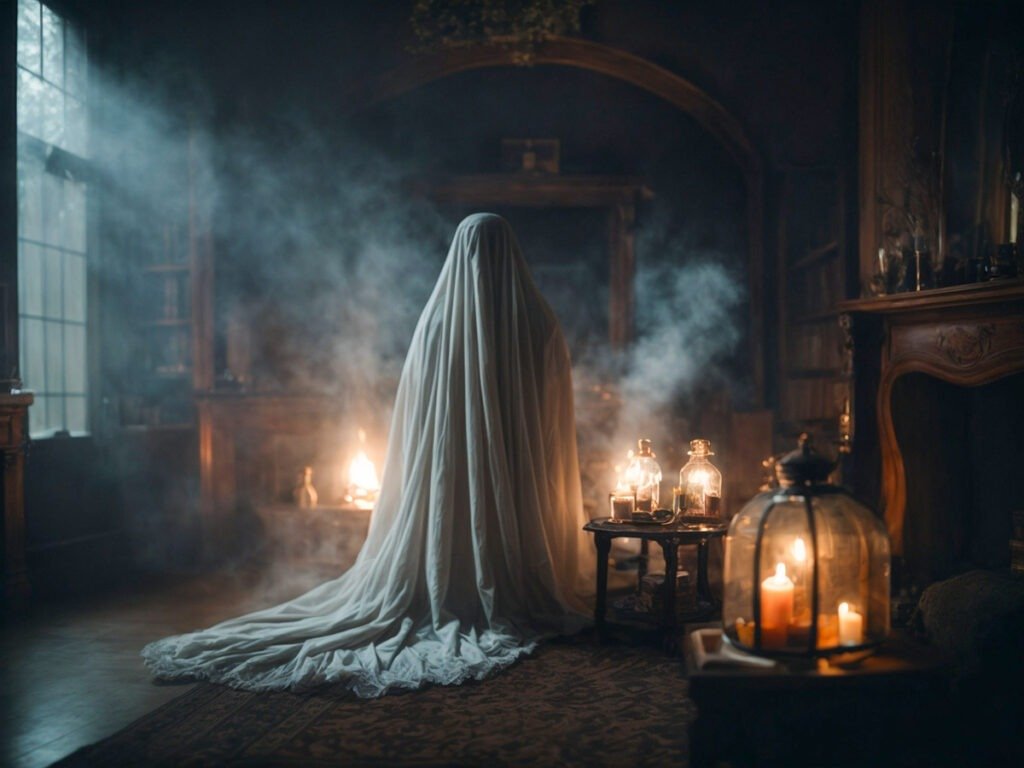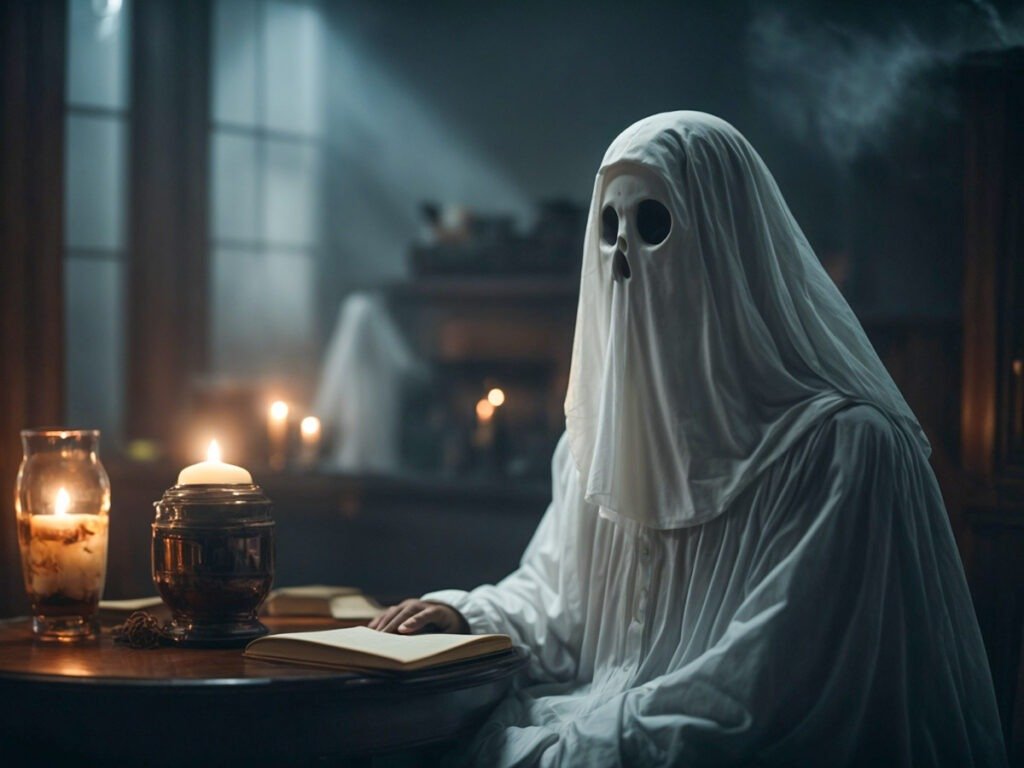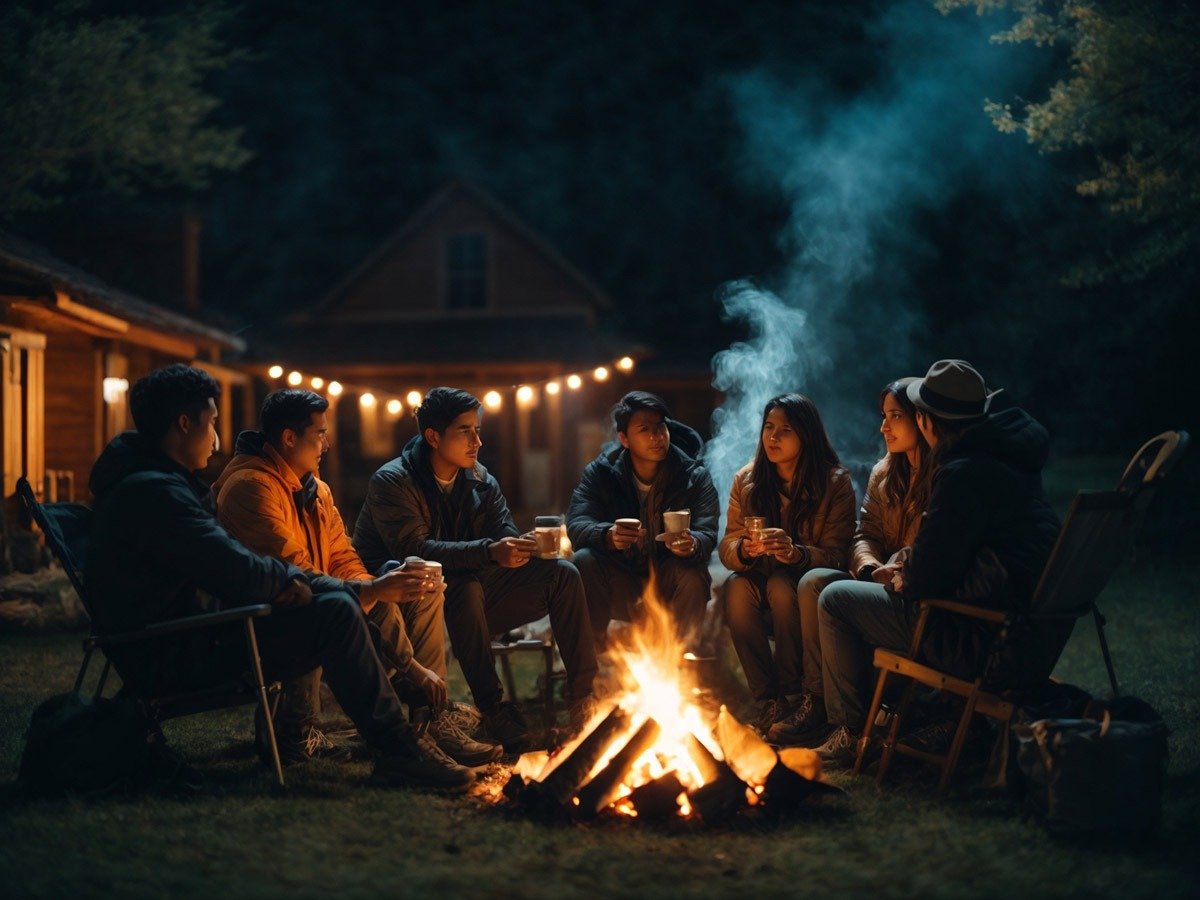If you’ve ever found yourself gathered around a campfire, surrounded by the darkness of the night and the hushed whispers of your friends, then you know the perfect setting for a spooky ghost story. Whether you’re a seasoned storyteller or new to the craft, learning how to craft a bone-chilling tale can add an extra level of excitement to your outdoor adventures. In this article, you’ll discover tips and tricks on creating the best ghost stories that will have your audience hanging onto every word and jumping at every unexpected sound. Prepare to be the master of fright and suspense during your next camping trip or glamping getaway. Get ready to learn how to craft spooky ghost stories that will send shivers down your listener’s spine.
Choosing the Setting
When crafting a spooky ghost story, choosing the right setting is crucial to creating the desired atmosphere and engaging your readers. There are several approaches you can take when selecting a setting for your ghost story.
Research-haunted locations
One way to add authenticity and intrigue to your story is to research real-life haunted locations. From abandoned houses to eerie forests or ancient castles, these places have a history of reported paranormal activity. By incorporating the essence of these haunted locations into your story, you can tap into the existing fascination people have with the supernatural.
Use Familiar Locations
Another option is to use familiar locations that evoke a sense of comfort and safety in order to contrast with the supernatural elements of your story. By setting your ghost story in a seemingly ordinary place, like a cozy cottage or a small town, you can heighten the suspense and make the ghostly encounters even more unexpected and unsettling.
Create a Unique Setting for Your Spooky Ghost Story
If you want to take a more creative approach, consider inventing a completely unique setting for your ghost story. This can be a fictional town, a hidden realm, or even a parallel dimension. By designing a one-of-a-kind setting, you have the freedom to tailor every aspect of the environment to suit your story’s needs, allowing for endless possibilities and unexpected twists.
Developing the Characters
In order to captivate your readers, it is essential to create compelling and mysterious characters that will draw them into your ghost story. Here are some suggestions on how to develop the characters in your narrative.
Create Mysterious Main Characters
The main characters of your ghost story should possess an air of mystery and intrigue. You can achieve this by giving them secretive pasts, enigmatic personalities, or unusual abilities. By keeping certain aspects of their lives hidden from the readers and revealing them gradually throughout the story, you can maintain a sense of suspense and deepen the readers’ curiosity.
Add Supporting Characters
Supporting characters play a vital role in adding depth and complexity to your ghost story. They can act as foils for the main characters, providing contrasting personalities or perspectives. Introducing supporting characters with their own secrets, fears, and desires can help create additional layers of tension and intrigue within your story.
Incorporate Historical Figures
To add an extra layer of authenticity and intrigue to your ghost story, consider incorporating real historical figures into your narrative. By intertwining supernatural elements with well-known historical events or figures, you can create a sense of believability and anchor your story to a specific time and place. This connection to reality can enhance the chilling effect of your ghost story and make it even more captivating for readers.
Building Suspense
Creating an atmosphere of suspense and tension in your ghost story is essential to keeping your readers engaged and on the edge of their seats. Here are some techniques you can use to build suspense effectively.
Start with a Captivating Opening
To immediately grab the readers’ attention, begin your ghost story with an intriguing and captivating opening. This could be a chilling scene, a mysterious event, or a foreboding description of the setting. By setting the tone from the very beginning and introducing a sense of unease or curiosity, you can hook your readers and compel them to continue reading.
Ramp up Tension
As your ghost story progresses, it is crucial to increase the level of tension and suspense gradually. This can be achieved through escalating supernatural encounters, unexpected plot twists, or the gradual unraveling of secrets and revelations. By carefully pacing your story and steadily raising the stakes, you can keep your readers gripped and eager to uncover the next chilling twist.
Utilize Foreshadowing
Foreshadowing is a powerful tool for building suspense and creating a sense of anticipation in your ghost story. By hinting at future events, dropping subtle clues, or using symbolism and metaphors, you can plant seeds of unease in your readers’ minds. This technique allows you to build an air of mystery and keep your audience guessing, heightening their engagement with your story.

Establishing the Ghost
The ghost is a central element of any ghost story, and establishing its presence effectively is crucial to creating an eerie and captivating narrative. Here are some key aspects to consider when introducing and developing your ghost character:.
Define the Ghost’s Appearance
The appearance of your ghost plays a significant role in setting the tone and atmosphere of your story. Whether it’s a translucent figure, a shadowy apparition, or a decaying spirit, the description of your ghost should be vivid and chilling. Consider using vivid imagery and evocative language to paint a clear picture that elicits fear and uncertainty in your readers.
Convey the Ghost’s Backstory
A ghost is not just a faceless entity; it has a backstory that adds depth and intrigue to its character. Develop the ghost’s history and motives, giving it a compelling reason for haunting the location or interacting with the living characters. By revealing bits of the ghost’s past, you can create empathy and understanding for its actions, making it a more complex and dynamic character.
Reveal Ghostly Abilities
A ghost’s abilities can range from subtle manifestations to terrifying displays of power. Decide on the level of supernatural abilities your ghost possesses, such as the ability to manipulate objects, create eerie noises, or even harm the living. Introduce these abilities gradually, using them to escalate the tension and create chilling moments throughout your story.
Crafting Twists and Turns
To keep your readers engaged and on the edge of their seats, incorporating unexpected plot twists and misguiding the reader can add excitement and surprise to your ghost story. Here are some techniques to consider when crafting twists and turns in your narrative.
Introduce Unexpected Plot Twists
Plot twists are a great way to keep your readers guessing and add excitement to your ghost story. Introduce unexpected revelations, secret connections, or unexpected character actions that challenge the readers’ assumptions and force them to reevaluate what they thought they knew. These plot twists can inject new life into your story and provide thrilling moments of surprise.
Misguide the Reader
Leading your readers astray with misdirection and false clues can generate suspense and keep them engaged in your ghost story. By planting breadcrumbs that point in the wrong direction or creating red herrings, you can keep your readers guessing and ensure that the true nature of the ghostly occurrences remains a mystery until the right moment.
Leave Room for Interpretation
To add an extra layer of intrigue and engage your readers’ imagination, leave some aspects of your ghost story open to interpretation. Offering multiple possible explanations or ambiguous endings allows readers to formulate their own theories and conclusions. This not only creates a sense of involvement but also sparks discussion and enhances the overall impact of your story.
Utilizing Atmospheric Elements
Creating a chilling atmosphere is essential in a ghost story, as it sets the stage for supernatural encounters and creates a sense of unease. Here are some atmospheric elements you can utilize to enhance the spooky ambiance of your narrative.
Create a Chilling Atmosphere
Describe the setting in vivid detail, emphasizing its eerie qualities. Consider incorporating weather elements such as dense fog, howling winds, or torrential rain to heighten the sense of foreboding. By creating a chilling atmosphere, you can immerse your readers in a world of suspense and anticipation.
Incorporate Eerie Sounds
Sound can be a powerful tool for enhancing the spookiness of your ghost story. Describe the unsettling, unidentifiable noises that echo through the haunted locations—creaking floors, distant whispers, or haunting melodies. These eerie sounds can contribute to the overall sense of unease and create a more immersive reading experience.
Use Sensory Descriptions
Engage your readers’ senses by incorporating vivid sensory descriptions throughout your ghost story. Describe the dank, musty scent of decaying wood or the icy touch of ghostly apparitions. By appealing to the readers’ senses, you can make them feel as if they are experiencing the ghostly occurrences themselves, heightening their emotional response and investment in the story.

Writing Engaging Dialogue
Engaging dialogue is essential in any narrative, and ghost stories are no exception. Well-crafted dialogue can reveal secrets, create tension, and deepen the readers’ connection to the characters. Here are some tips for writing engaging dialogue in your ghost story.
Give Each Character a Distinct Voice
Each character in your ghost story should have a distinct voice that reflects their personality, background, and motives. Consider their age, education, and experiences when crafting their dialogue, as this will help make their speech more authentic and interesting. Distinct voices not only add depth to your characters but also make it easier for readers to differentiate and engage with them.
Use Dialogue to Reveal Secrets
Dialogue can be a powerful tool for slowly unveiling secrets and building suspense in your ghost story. Characters can drop hints, share cryptic messages, or confess hidden truths in their conversations. By strategically placing these revelations within the dialogue, you can keep your readers intrigued and eager to uncover the mysteries hidden within your story.
Include Suspenseful Exchanges
To heighten the tension and create a chilling atmosphere, craft suspenseful exchanges between characters. Utilize dialogue that is filled with veiled threats, cryptic warnings, or tense confrontations. These exchanges will keep readers on edge and eager to discover the outcome of these intense interactions, adding excitement and intrigue to your ghost story.
Employing Foreshadowing
Foreshadowing is a literary technique that allows you to hint at future events in your ghost story. By laying the groundwork for what’s to come, you can create a sense of unease and anticipation in your readers. Here are some ways to employ foreshadowing effectively.
Hint at Future Events
Introduce subtle clues, signs, or recurring motifs that hint at the upcoming ghostly encounters or plot twists in your story. These hints can be as simple as unexplained phenomena, brief moments of unease, or symbols that appear throughout the narrative. By strategically placing these hints, you can build anticipation and create a sense of impending doom.
Use Symbolism and Metaphors
Symbolism and metaphors can be powerful tools for foreshadowing events and creating a sense of unease. Incorporate symbols or metaphors that represent key elements of your story, such as a cracked mirror reflecting the shattered past or a flickering candle symbolizing the fleeting nature of life. These symbolic elements can add depth to your ghost story and create a cohesive narrative.
Create a Sense of Unease
Foreshadowing can also be employed to create an overall sense of unease throughout your ghost story. Use descriptions, dialogue, or subtle hints to establish a feeling of impending danger or unrest. By instilling a sense of unease, you can keep your readers engaged and ensure their continued investment in the narrative.
Adding Emotional Depth
To make your ghost story truly memorable, it is essential to add emotional depth to your characters and explore themes of loss, regret, and redemption. Here are some techniques to consider when adding emotional depth to your narrative.
Explore Themes of Loss and Regret
The specter of loss and regret can add emotional weight to your ghost story. Explore the impact of past tragedies or missed opportunities on your characters, allowing their experiences to shape their actions and motivations. By delving into these themes, you can elicit empathy from readers and create a more poignant and relatable narrative.
Evoke Empathy for the Characters
Craft characters with whom readers can empathize, characters whose struggles and desires resonate with the human experience. By making your characters relatable, readers will become emotionally invested in their journey and the outcome of the ghostly encounters. This emotional connection will heighten the impact of the story and leave a lasting impression.
Show the Ghost’s Motivations
The ghost in your story should be more than just a malevolent presence – it should also have motivations and desires that resonate with the readers. Delve into the ghost’s past, exploring the circumstances that led to its haunting, and reveal its longing for closure, revenge, or connection. By humanizing the ghost, you can create a more layered and emotionally engaging narrative.
Crafting a Memorable Ending
The ending of your ghost story is what will leave a lasting impact on your readers, so it is crucial to deliver a conclusion that is surprising, thought-provoking, and haunting. Here are some key elements to consider when crafting a memorable ending.
Deliver a Surprising Conclusion
To leave a lasting impression, your ghost story’s ending should deliver a surprising twist or revelation that defies the readers’ expectations. Subvert their assumptions and provide a resolution that is unexpected yet satisfying. This unexpected conclusion will stay with readers long after they finish your story, ensuring its place in their memories.
Leave Room for Speculation
A great ghost story often leaves readers with lingering questions and room for speculation. Consider ending your narrative with a few loose ends or unanswered mysteries that invite readers to formulate their own theories and interpretations. This open-endedness allows the story to continue to resonate with readers even after they have finished reading.
Create a Haunting Final Image
End your ghost story with a vivid and haunting final image that lingers in the readers’ minds. This could be a chilling description, a poignant moment of revelation, or an evocative metaphor that encapsulates the essence of your story. By leaving readers with a final image that encapsulates the atmosphere and emotion of your narrative, you ensure a lasting impact and a memorable reading experience.
In conclusion, crafting a spooky ghost story requires careful attention to various elements. From choosing the right setting and developing intriguing characters to building suspense, utilizing atmospheric elements, and delivering a memorable ending, each aspect plays a vital role in creating a compelling and haunting narrative. By following these guidelines and infusing your own creativity, you can spin a ghostly tale that will captivate readers and leave them with a lingering sense of unease. Happy storytelling!




